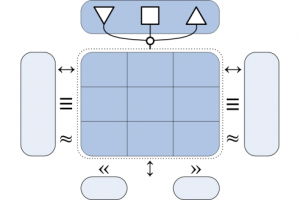The Quest for the Enterprise Canvas
[There is, as usual, a serious point to this post. Yet a gentle note to Americans and other non-English speakers: much what follows is riddled with puns and other artefacts of that imaginary entity called ‘British humour’. My apologies… You Have Been Warned etc… 🙂 ]
From long ago, in the lost land of Rubb, there is tell of a lore-full legend: the Quest for the Enterprise Canvas. This strange saga begins with the following poem, herewith transcribed from the original Rubbish:
Three maps for the bizarchs high upon the office sky
Seven for the itarchs who hide below alone
Nine for the sysarchs, doomed to sigh
One for the entarch on his dark throne
One map to rule them all, one map to find them
One map to bring them all and with mad humour bind them(with acknowledgements and apologies to JRR Tolkien…)
It’s true that much may have been Lost In Translation, yet it seems that at the time the island was populated by an odd tribe of overburdened architects, each with their own specialist views: business-architects, IT-architects, systems-architects, and so on. One small caste – the enterprise architects – were tasked with overall overview: the note about ‘his dark throne’ appears to reference their continual struggle against being ‘in the dark’ about what was going on in the enterprise. Hence to them was assigned the ‘one map to rule them all’ – the fabled Enterprise Canvas.
This miraculous model-type had for many years been scoffed at by scholars, dismissed as mere myth, an imaginary artefact from the dawn of time; yet we can now reveal that it did indeed exist. What is more, by careful analysis of cross-references in ancient manuscripts such as the Zachman Codex, the Book of Bmgen and The Chronicles of the Af Family (the mapmaker-brothers Togaf, Feaf, Peaf, Modaf, Dodaf and their cousins Itil and Iso), we now know what it once looked like, and what it could do. Some garbled hints of the shape and structure of this definitive diagram have occurred throughout history:
Yet here, at last, is its true form:
We know that this strange symbol was a way to describe services throughout the enterprise, each positioned at a cross-over of value and action. (Those of a religious disposition once interpreted this as a sign of the ‘holy cross’, but we now know that it was because people became Wholly Cross when things went wrong…).
Yet the full story of what it all means, and how to use it, will have to wait until the next post… Watch This Space? 🙂


It’s R2D2 or Robbie the robot!
And Tom is Yoda!